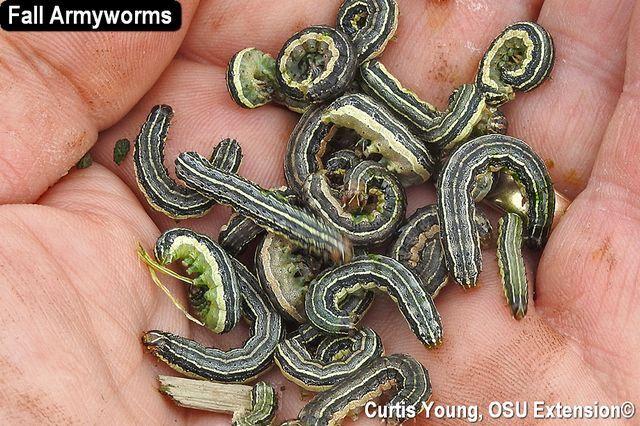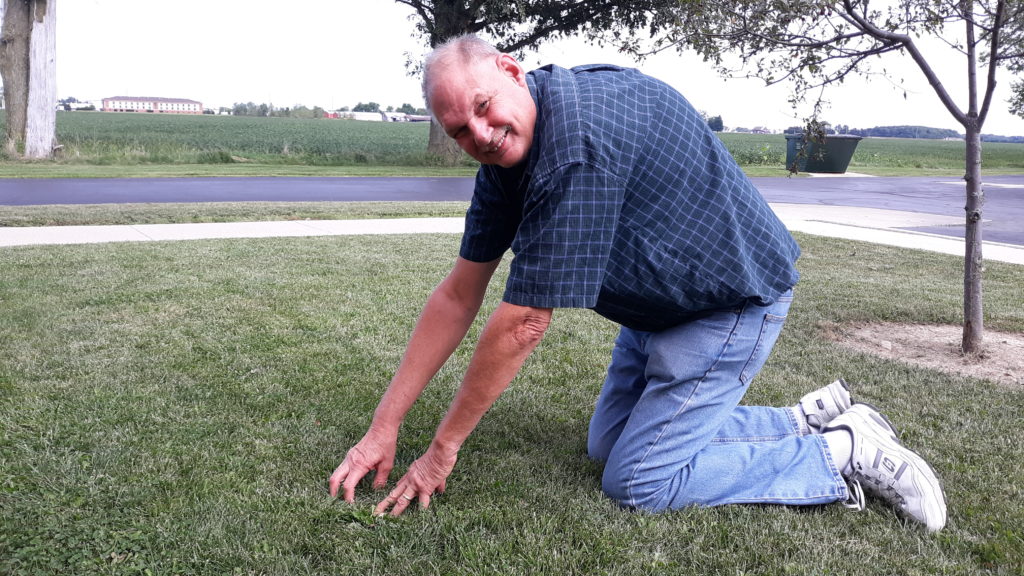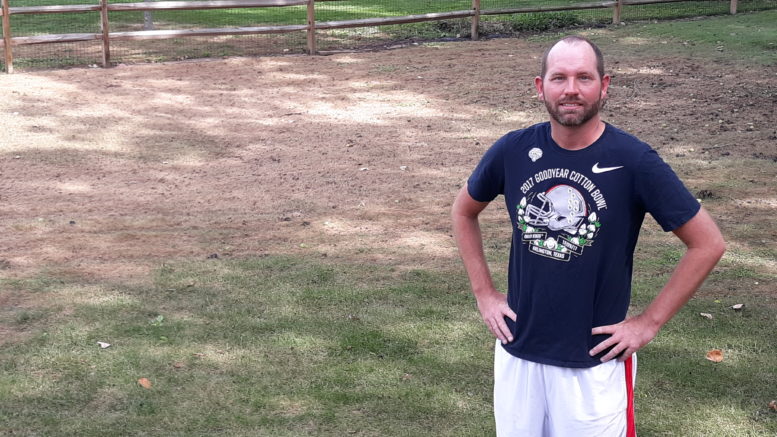By JAN LARSON McLAUGHLIN
BG Independent News
Dennis Flowers spends hours each week, tending to his lush green lawn on the west side of Bowling Green.
“Last Thursday I mowed, and my yard was fine,” Flowers said.
But a week later, much of his backyard was brown.
His lawn – like many across Wood County – had been invaded by Armyworms.
When the brown swatches started showing, Flowers thought the grass was struggling with the recent heat wave. But within three days, the brown grass had spread, creeping into his side yard and into neighbors’ backyards.
“I put 2 and 2 together,” and followed instructions on how to tell if Armyworms were the culprit. The wriggling worms surfaced, and Flowers went to a farm supply store to get a product to get rid of them.
“I’m just hoping my yard comes back,” he said.
Flowers is far from alone. The Wood County OSU Extension Office is receiving calls from residents across the county about the mysterious browning of their yards. The Perrysburg and Rossford areas have seen the largest assault from the Armyworms, according to Craig Everett, horticulturist with the extension office.
Everett took a call last week from a family who returned home from vacation to find their entire lawn brown.
“People are losing their lawns and are very angry,” he said.
The Armyworms don’t attack every year in Wood County because they are a southern species, and migrate here during strong weather systems. It is believed that the Armyworm moths arrived roughly five weeks ago, after a major storm front blew up to this region from Texas, Florida and Georgia.
“They rode those air currents up north,” Everett said.
The moths are particular – and pick certain lawns to lay their eggs on.
“They like lawns that are highly maintained,” with nicer Kentucky Bluegrass or perennial rye grass, Everett said. “They prefer manicured lawns.”

The moths then lay their eggs. Each adult female can produce an egg mass that contains 100 to 500 eggs. The eggs hatch in five to seven days, and the larvae (worms) usually take three to four weeks to complete their pupation stage.
When the eggs hatch, the Armyworm larvae have the potential to devour an entire lawn.
“They move en masse, like an army rolling across the lawn eating everything in their wake,” Everett said.
In three days or less, the Armyworms can kill an entire lawn, he said.
The worms devour the grass blades, leaving the crown of the grass exposed. The sun and dry conditions can then kill the rest of the grass.
When that happens, the grass will not recover, Everett said.
“Their lawn is not going to come back,” he said.
But Everett cautioned that all brown grass is not the result of an Armyworm invasion.
“We just came off of 14 days of 90 degrees plus heat,” he said. And this is the time of year when grass starts its dormant stage.

To determine if Armyworms are the culprit, residents are advised to mix soapy water (a half ounce of dishwashing soap and a gallon of water) and pour it over a patch of grass.
“It irritates their membranes and brings them to the surface,” Everett said. The worms are greenish-brown, with a stripe down their bodies, which can be up to three inches long.
The extension service offered the following tips if Armyworms attack:
- The first step in protecting your lawn is to kill the caterpillars before they completely devour the turfgrass canopy. This involves the direct application of insecticides.
- Armyworms tend to feed in the morning and late afternoon and evening. Applying a liquid Synthetic Pyrethroid insecticide to your lawns in the morning should give control. Synthetic Pyrethroid products available for home use include one of these active ingredients: Bifenthrin, Cyfluthrin, gamma-cyhalothrin and lamba-cyhalothrin.
- If you missed the first step, the second step is to save the crowns. The crowns without the grass canopy can dry out so watering the damaged areas in the heat of the day will keep the crowns cooled down and hydrated.
- Apply enough water to hydrate the crowns without saturating the soil, however, apply enough water to keep the root zone moist. This should be kept up daily until a visible green cover returns to shade the crowns. To aid the grass recovery effort, an application of a fall fertilizer product will help. The fertilizer should include a slow-release form of nitrogen to support turfgrass growth over a longer period of time.
- If there is a concern that crowns are being lost — for example, if irrigation is not possible due to various reasons — now is the time to look for grass seed as the supply of seed is down this year.
The insecticide needed to kill off the larvae may be difficult to find, since the growing season is near the end, Everett said.
“Box stores are transitioning to Christmas stuff,” he said, suggesting that people go to local farm supply stores to find the insecticide. Even then it may be in short supply.
“Because this is going on across the state, the supply chain is low,” he said. “People are going to have to hunt around to find this.”
Everett recommended the liquid formulations rather than granular, since the liquid starts working immediately.
The Armyworms cannot survive Ohio winters. However, local residents should be aware that there may be another hatch of the larvae in mid to late September. A frost will kill the larvae, but there may be time for them to assault more lawns before freezing weather comes.

